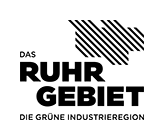Component Design
SolidWorks
SolidWorks is 3D CAD software used for design and product development in many technical fields. It can be used to create, visualize, and analyze precise models of components and assemblies. Design engineers can quickly make changes and create variants using parametric modeling. Technical drawings and parts lists are also created automatically and in accordance with standards. SolidWorks thus supports an efficient development process.
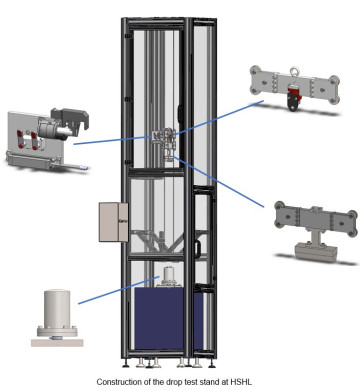
Testing the energy absorption capacity of materials using drop tests
The drop test rig was designed, programmed, and commissioned as part of student projects. It enables standard-compliant testing of protective equipment, for example, in accordance with its application.
Artec Eva
The Artec Eva handheld scanner is a lightweight, portable 3D scanning system that is particularly suitable for fast and accurate capture of medium-sized objects. It works without contact and captures detailed geometries and color information in high resolution. It is ideal for applications in industry, design, or medicine. Combining speed, accuracy, and mobility, the Artec Eva enables efficient digitization of real objects. The scans can be seamlessly integrated into software such as SolidWorks or Freeform for further processing. This makes it a multifunctional tool in modern product development and quality assurance.
Technical data:
- Point accuracy 0.1 m
- Resolution 0.2 mm
- 3D reconstruction rate 16 FPS
- Data acquisition speed 18 million points/sec
- Working distance 0.4-1 m
- 3D exposure time 0.0002 sec
Manufacturing customized products using 3D scanning
With the help of the scanner, parts of a person's body can be converted into digital computer models. These are subsequently used to design customized products, such as a bicycle helmet with an optimized fit and cushioning function.
VL-700 Optical 3D Coordinate Measuring Device
The VL-700 stationary 3D scanner is a high-precision measuring system for non-contact measurement of complex components and delivers detailed 3D data in a short time. The scanner is particularly suitable for quality control, surveying, and reverse engineering. Its automatic rotation axis allows the object to be captured from different angles, enabling complete and accurate digitization. The VL-700 thus stands for precise measurement technology and efficient integration into existing development and testing processes.
Technical data:
- Measuring accuracy: ± 10 µm
- Repeatability: 2 µm
- Measuring resolution: 9 million points
- Object table: Ø 500 mm, 360° rotation, 45° tilt
- Measuring range (Ø x H):
- Low magnification: 300 x 200 mm
- High magnification: 70 x 50 mm
- Extended field of view (Ø x H):
- Low magnification: 500 x 200 mm
- High magnification: 110 x 50 mm
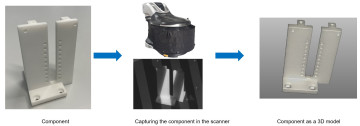
HSHL
3D Systems Touch and Geomagic Freeform
The 3D Systems Touch is a haptic input device that was developed specifically for intuitive 3D modeling and virtual design. It allows users to “feel” and edit three-dimensional objects with a pen, just as if they were working with a real tool. The combination of haptic feedback and precise control makes it ideal for applications in product development or industrial design. In conjunction with Geomagic Freeform software, digital modeling can be made particularly natural and efficient. Direct tactile feedback makes design processes more tangible and controllable.
Technical data:
- Working area: 431 x 348 x 165 mm
- Positioning with six degrees of freedom
- Position resolution: 0.055 mm
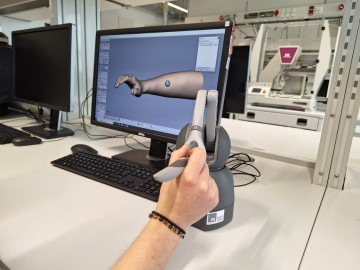
Simulation
SolidWorks Simulation
SolidWorks Simulation offers a wide range of FEM applications for simulating and optimizing components. Mechanical studies can be performed on a wide range of materials under different types of stress in order to predict the realistic behavior of components. In addition, design studies can be carried out to improve components. For example, topology optimization serves as the basis for lightweight components depending on the specific load case.
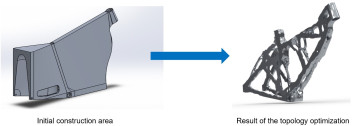
Simulation of a bicycle frame under realistic boundary conditions using FEM
FEM simulation is used to predict component behavior. Both simple, static loads and complex load cases, such as those acting on a bicycle frame while riding, can be simulated.
SolidWorks Plastics
SolidWorks Plastics is used to simulate the filling and cooling processes in injection molding. The flow behavior of the melt can be modeled based on your own rheological measurement data. This allows the manufacturability of components in this process to be assessed and optimized by identifying possible defects such as warping or sink marks and correcting them by adjusting the design or process parameters. In addition to improving component quality, this significantly reduces development time.
ANSYS Mechanical
ANSYS is one of the leading FEM solutions for simulating mechanical and thermal stresses on components. It enables simulation under various types of stress and offers advanced material modeling capabilities. Coupling with the commercial software Digimat also enables the simulation of additively manufactured components, taking into account process-related properties.
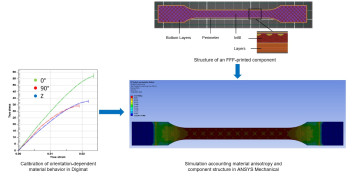
Digimat
Digimat is an interface for simulating additively manufactured components. Thermal simulation can be used to predict the cooling behavior and thus the distortion during the manufacture of components. In addition, coupling with classic FEM is possible, which takes into account the manufacturing-related anisotropy of 3D-printed components, which has a decisive influence on their mechanical properties.
ANSYS Rocky
ANSYS Rocky enables the simulation of particles using the discrete element method (DEM). Collisions between particles are detected and the contact forces are calculated on this basis. This makes it possible to predict the position of each individual particle in space over time. A wide variety of materials and particle geometries can be defined and simulated in different environments with realistic boundary conditions. This means that both fine powders and bulk materials with large particles can be represented.
Simulation of the angle of repose of a powder using the discrete element method (DEM)
DEM models powder particles discretely based on their properties (particle size, flow behavior, etc.). This allows the movements of the particles and their interactions to be simulated.
nTop
nTop allows components to be designed on the basis of computer-aided designs and has many applications, particularly in additive manufacturing and product development. Using a mathematical modeling approach, the software enables the development of complex structures that are required, for example, in the design of lattice structures and digital foams. This makes it easy to vary mechanical properties such as damping capacity.




